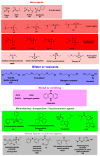Hazardous Materials from Threats to Safety: Molecularly Imprinted Polymers as Versatile Safeguarding Platforms
- PMID: 39408411
- PMCID: PMC11478541
- DOI: 10.3390/polym16192699
Hazardous Materials from Threats to Safety: Molecularly Imprinted Polymers as Versatile Safeguarding Platforms
Abstract
Hazards associated with highly dangerous pollutants/contaminants in water, air, and land resources, as well as food, are serious threats to public health and the environment. Thus, it is imperative to detect or decontaminate, as risk-control strategies, the possible harmful substances sensitively and efficiently. In this context, due to their capacity to be specifically designed for various types of hazardous compounds, the synthesis and use of molecularly imprinted polymers (MIPs) have become widespread. By molecular imprinting, affinity sites with complementary shape, size, and functionality can be created for any template molecule. MIPs' unique functions in response to external factors have attracted researchers to develop a broad range of MIP-based sensors with increased sensitivity, specificity, and selectivity of the recognition element toward target hazardous compounds. Therefore, this paper comprehensively reviews the very recent progress of MIPs and smart polymer applications for sensing or decontamination of hazardous compounds (e.g., drugs, explosives, and biological or chemical agents) in various fields from 2020 to 2024, providing researchers with a rapid tool for investigating the latest research status.
Keywords: CWA agents; decontamination; explosives; hazardous compounds; illicit drugs; imprinting techniques; molecularly imprinted polymers; multi-stimuli responsive; sensing.
Conflict of interest statement
The authors declare no conflict of interest.
Figures








Similar articles
-
[Recent advances in applications of fragment/dummy molecularly imprinted polymers].Se Pu. 2021 Feb;39(2):134-141. doi: 10.3724/SP.J.1123.2020.08008. Se Pu. 2021. PMID: 34227346 Free PMC article. Chinese.
-
Carbon nanomaterial-based molecularly imprinted polymer sensors for detection of hazardous substances in food: Recent progress and future trends.Food Chem. 2023 Sep 15;420:136100. doi: 10.1016/j.foodchem.2023.136100. Epub 2023 Apr 1. Food Chem. 2023. PMID: 37062085 Review.
-
Recent Advances and Perspectives of Molecularly Imprinted Polymer-Based Fluorescent Sensors in Food and Environment Analysis.Nanomaterials (Basel). 2019 Jul 18;9(7):1030. doi: 10.3390/nano9071030. Nanomaterials (Basel). 2019. PMID: 31323858 Free PMC article. Review.
-
[Application of novel quantum dot-based molecularly imprinted fluorescence sensor in rapid detection].Se Pu. 2021 Aug;39(8):775-780. doi: 10.3724/SP.J.1123.2021.02025. Se Pu. 2021. PMID: 34212579 Free PMC article. Review. Chinese.
-
Recent progress of the research of metal-organic frameworks-molecularly imprinted polymers (MOFs-MIPs) in food safety detection field.Food Chem. 2024 Nov 15;458:140330. doi: 10.1016/j.foodchem.2024.140330. Epub 2024 Jul 3. Food Chem. 2024. PMID: 38970953 Review.
References
-
- Guo J., Luo C. Risk assessment of hazardous materials transportation: A review of research progress in the last thirty years. J. Traffic Transp. Eng. (Engl. Ed.) 2022;9:571–590. doi: 10.1016/j.jtte.2022.01.004. - DOI
-
- Noll G.G., Hildebrand M.S., Schnepp R., Rudner G.D. Hazardous Materials: Managing the Incident. Jones & Bartlett Learning; Burlington, MA, USA: 2014.
-
- Houck M.M., Siegel J.A. Chapter 13—Illicit Drugs. In: Houck M.M., Siegel J.A., editors. Fundamentals of Forensic Science. 2nd ed. Academic Press; San Diego, CA, USA: 2010. pp. 305–340.
-
- Üzümcü A. Working Together for a World Free of Chemical Weapons, and Beyond. Nobel Peace Prize Lecture OPCW. 2013. [(accessed on 10 December 2023)]. Available online: www.nobelprize.org.
Publication types
LinkOut - more resources
Full Text Sources

